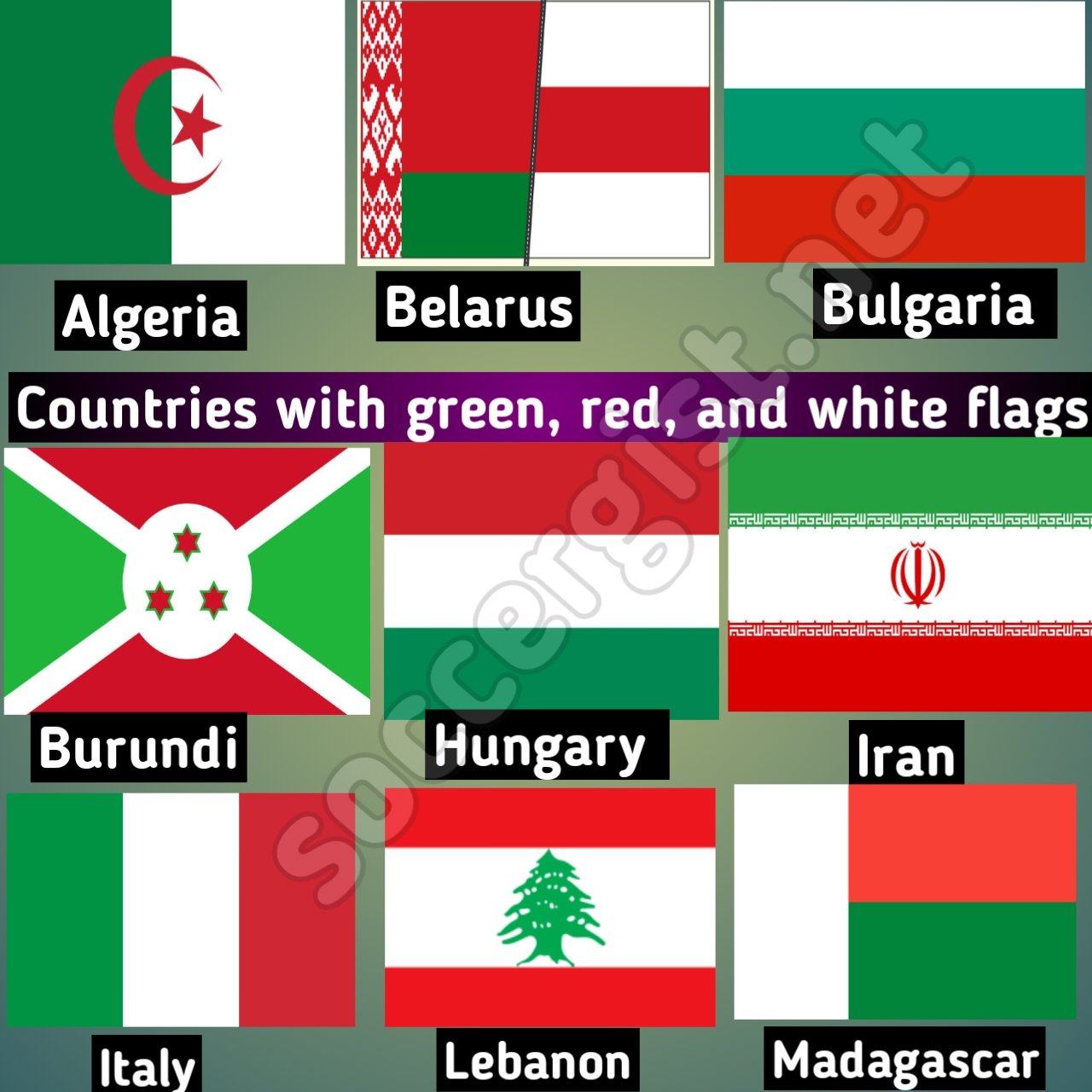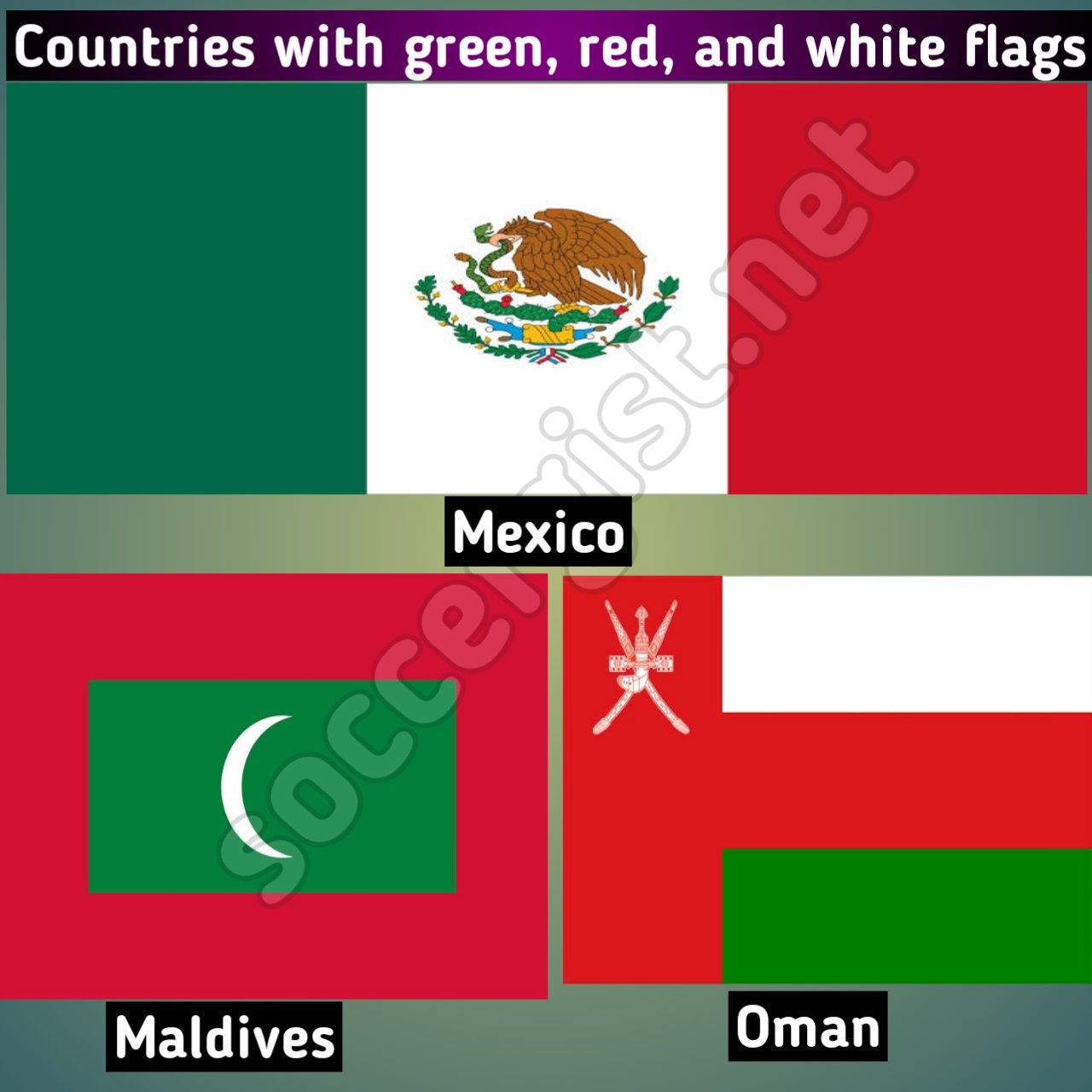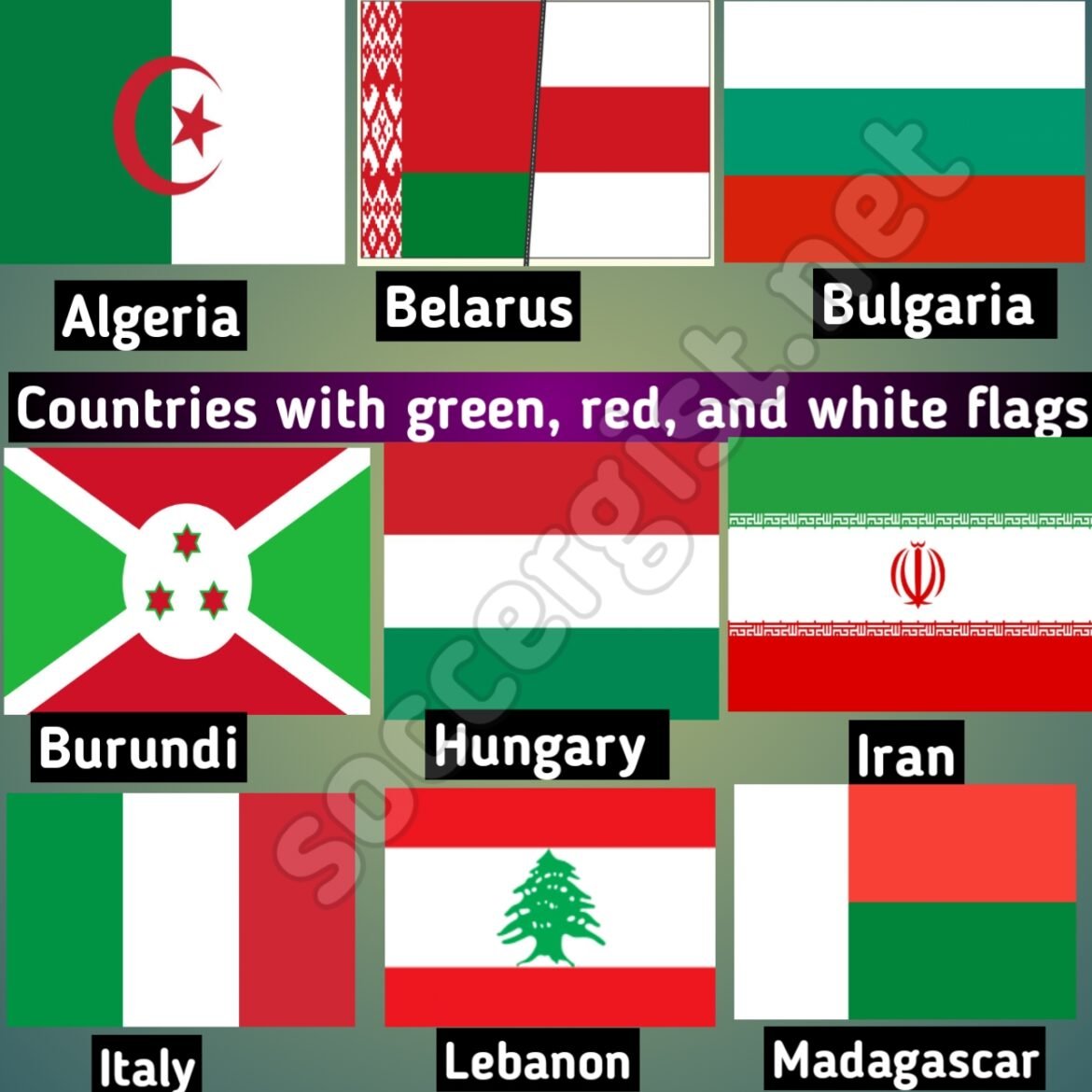Table of Contents
Every flag tells a unique story and that of a country’s flag is no different. Predominantly, there are quite a number of countries that proudly adorn their flags with the colors green, red, and white. Each color holds its significance and symbolism which ultimately represents what the country stands for.

countries_with_green_red_and_white_flags
A brief overview of the significance of flags and their color symbolism
Often, the color green on a flag symbolizes the natural richness of the land, representing hope, joy, and love, whereas red typically signifies bravery, strength, or valor. Similarly, white often represents peace and honesty. Some of the countries that wave a green, red, and white flag include Italy, Mexico, and Iran, each weaving a unique narrative through their tricolor flags.
In summary, flags are more than just symbolic representations of a nation. They embody the country’s history, its aspirations, values, and its spirit. These tri-color flags, imbued with the colors green, red, and white, are a classic representation of their country’s identity, each telling an endearing tale of its own.
Also check out; 20 Countries With Red and White Flags (Symbolize, Meaning and Fact)
Fascinating Facts: History and Evolution of the Italian, Irish, and Mexican Flags Comparison
Popular Countries with Green Red and White Flags
There are currently 12 popular countries:
- Algeria
- Belarus
- Bulgaria
- Burundi
- Hungary
- Iran
- Italy
- Lebanon
- Madagascar
- Maldives
- Mexico
- Oman
Algeria
Unleashing a sense of pride, the flag of Algeria embodies a rich history and robust cultural significance. It’s a beautiful emblematic banner, colored in green, white, and red with a central red star and crescent.
Features and symbolism of the Algerian flag
The Algerian flag utilizes distinctive colors to portray its underlying meaning. The green half symbolizes the beauty of nature and Islam, while the other white half represents purity and peace. Emblazoned in the center is a red star and crescent, which is an internationally recognized symbol of Islam, again illustrating Algeria’s majority Muslim population.
Historical background and cultural significance
The flag was adopted on July 3rd, 1962, when Algeria gained its independence from France. It symbolizes the extravaganza of the Algerian revolution and has since become a proud insignia for the people of Algeria, representing their struggle, independence, and cultural identity. The flag continues to hold a place of honor and respect in every Algerian’s heart.
Belarus
Would generating fascinating memorable trivia about countries gets you thrilled? Well then, brace yourself as we plunge into a vibrant journey exploring the Belarusian flag.
Description and meaning of the Belarusian flag
The Belarusian flag uniquely sets itself apart featuring the colors green, red, and white. It’s not just a simple piece of cloth; the flag represents the pride, history, and cultural symbolism of the Belarusian people.
Significance of the color arrangement and symbolism
The green strip at the bottom signifies the future, representing the hope and said to pay homage to the country’s vast, lush forests. Above that rests a larger red band symbolizing the past with a rich tapestry including the bloodshed in battles. The intriguing white ornamentation on the left boasts a traditional Belarusian woven cloth pattern. So, the Belarusian flag represents Belarusian people’s blending and progression of their past, present, and future.
Bulgaria
Known for its rich history, vibrant culture and beautiful natural landscapes, Bulgaria is also identifiable through her unique flag.
The flag of Bulgaria and its representation of the nation
The Bulgarian flag boasts three identical horizontal bands of white, green, and red. The white symbolizes peace, love, and freedom; the green signifies youthfulness, hope, and the welcoming nature of Bulgarians. The red represents the valor of the nation in the face of adversity.
Historical context and symbolic interpretations
The current version of the Bulgarian flag came to existence after the Russo-Turkish War in 1877. The flag has seen Bulgaria through pivotal events in history, including both the World Wars and the Communist era, making it an emblem of the country’s resilience and pride.
Burundi
In the heart of Africa, sits the vibrant nation of Burundi. This East African country is represented by a striking flag composed of green, red, and white colors. Despite its small size, Burundi possesses a rich culture and tumultuous history, clearly reflected through the symbolism in its flag.
Significance and symbolism of the Burundian flag
Created after independence from Belgium in 1962, the Burundian flag consists of a white saltire which divides the field into alternating red and green areas. The flag’s colors bear significant meanings: Green symbolizes hope, white represents peace, and red is for the struggles towards independence. The three discs in the center stand for the three national values: unity, work and progress.
Cultural and historical references
The flag transcends its status of a national icon, and serves as a vibrant reminder of Burundi’s rich cultural past and its hopeful future. The colors and symbols are deeply embedded in Burundian folklore, history, and social fabric. They encapsulate stories of persistence, unity, and progress that have shaped the nation. Be it in art, music or storytelling, the flag stands as a historic reference and a source of cultural pride among Burundians.
Hungary
Hungary, often acclaimed as the “Land of Waters,” is as rich in its culture and history as its vibrant national flag. The Hungarian flag is a true embodiment of its tumultuous yet fascinating past.
Features and meaning of the Hungarian flag
The Hungarian flag, dominated by a horizontal tricolor of red, white, and green, beautifully portrays the diversified culture, valiant history, and resilience of its countrymen. The red stripe atop signifies strength, the white stripe in the middle reflects honesty and fidelity, and the green stripe at the bottom represents hope, fertility, and the bountiful nature of the country. Every time the Hungarian flag unfurls gracefully, it narrates a vibrant tale of the Hungarian’s journey to sovereignty, their undying spirit, and the hopes for a promising tomorrow.
Iran
Description and symbolism of the Iranian flag
The flag of Iran consists of three horizontal bands of green, white, and red. The green stripe represents Islam, which is the dominant religion in Iran. It also represents hope, growth, and prosperity. The white stripe symbolizes peace and honesty, while the red stripe represents bravery, courage, and martyrdom.
The flag’s design dates back to the early 20th century and has remained relatively unchanged since then. The colors of the flag are deeply rooted in Iranian history and culture, representing important values and beliefs held by the Iranian people.
The flag of Iran is often displayed alongside the national emblem, which features a stylized representation of Allah’s name. This emblem is an important symbol of Iran’s Islamic identity and is commonly seen on government buildings, official documents, and military insignia.
The Iranian flag holds great significance for the Iranian people, representing their national pride and identity. It is a powerful symbol that reflects the rich history, culture, and values of the country.
Italy
The Italian flag and its cultural and historical associations
Italy’s flag, known as Il Tricolore, consists of three vertical bands of equal width: green, white, and red. The flag’s design dates back to the 18th century and has strong cultural and historical associations.
The flag’s origin is linked to the Italian patriotic movement that emerged during the Napoleonic era. The green color symbolizes hope, the white represents faith, and the red represents charity and courage. These values were embraced by the Italian revolutionaries who fought for independence and the unification of Italy.
Symbolism of the colors and its significance to national identity
The colors of the Italian flag hold deep significance to Italy’s national identity. They represent the values and aspirations of the Italian people.
Green represents the lush landscapes that adorn the country, symbolizing the beauty and fertility of Italy. White symbolizes the purity and peace that Italians strive for as a nation. Red represents the bloodshed and sacrifices made during the struggles for freedom and unity.
The Italian flag is a powerful symbol that reflects Italy’s rich history, vibrant culture, and the aspirations of its people. It is proudly displayed during national celebrations, sporting events, and other significant occasions, serving as a reminder of Italy’s unique identity and the unity of its diverse regions.
Lebanon
Lebanon, a country in the Middle East, is known for its vibrant culture, rich history, and unique flag. The flag of Lebanon is a striking combination of three horizontal stripes – red, white, and green from top to bottom.
Features and symbolism of the Lebanese flag
The red stripe represents the sacrifices made by the Lebanese people for their independence and the bloodshed during their struggle. The white stripe symbolizes peace and purity, highlighting Lebanon’s commitment to unity and harmony. The green stripe represents Lebanon’s fertile land and the hope for a prosperous future.
The flag’s design is a tribute to Lebanon’s diverse heritage and the spirit of its people. The horizontal stripes are said to reflect the mountains, valleys, and slopes that shape the country’s breathtaking landscape.
The colors of the Lebanese flag are not only visually captivating but also carry great meaning and significance. They serve as a constant reminder of Lebanon’s resilience, unity, and the aspirations of its people.
Whether waving on a flagpole or displayed proudly during national events, the green, red, and white flag of Lebanon represents the country’s identity and serves as a powerful symbol of its history, culture, and aspirations for the future.
Madagascar
The flag of Madagascar and its representation of the country
The flag of Madagascar consists of three horizontal stripes – green, red, and white from top to bottom. Each color holds significance and represents various aspects of the country.
The green stripe represents the lush vegetation and the hope for a prosperous future. It symbolizes the importance of agriculture, which plays a vital role in the country’s economy.
The red stripe signifies the sovereignty and independence of Madagascar. It represents the sacrifices made by the people throughout history to fight for their freedom and maintain their unique cultural identity.
The white stripe represents purity, innocence, and the harmonious coexistence of different ethnic groups within the country. It represents the peaceful nature of the Malagasy people and their commitment to unity.
Together, these colors create a striking flag that reflects the natural beauty, rich history, and cultural diversity of Madagascar. The flag serves as a proud symbol of national identity and represents the hopes and aspirations of its people.
Maldives
Description and meaning of the Maldivian flag
The flag of Maldives consists of a green rectangle on the hoist side and a red rectangle on the fly side, separated by a vertical white stripe. The green area represents the nation’s beautiful tropical vegetation and its Islamic heritage, while the red symbolizes the blood shed by Maldivian heroes in defense of the nation’s independence. The white stripe stands for purity, honesty, and peace.
Symbolism and cultural significance
The flag of Maldives holds great cultural and historical importance for the nation. Each color and element carries a symbolism linked to the Maldivian identity. The green represents the lush greenery of the islands and their significance in the nation’s tourism industry. The red represents the bravery and sacrifices of the nation’s heroes. The white stripe represents the purity and peace that the Maldivian people strive for. Together, these colors and elements embody the unique culture and history of the Maldives, making the flag a proud symbol of the nation’s identity.

3_countries_with_green_red_and_white_flags
Mexico
Significance and symbolism of the Mexican flag
Mexico’s flag is a vibrant tricolor of green, white, and red from left to right. Each color represents different virtues and historical significance for the country.
The green stripe signifies hope and the country’s agricultural heritage, representing the lush landscapes and fertility of Mexico. It also symbolizes the Independence Movement led by Miguel Hidalgo in the early 19th century.
The white stripe represents purity, unity, and the Catholic faith. In addition, it stands as a reminder of the purity and sacrifice made by the heroes of the Mexican War of Independence.
The red stripe portrays the bloodshed and bravery of those who fought for Mexico’s independence. It represents the country’s struggle for freedom and justice.
The national coat of arms, prominently displayed at the center of the white stripe, is a symbol of Mexico’s rich history and cultural heritage. It showcases an eagle devouring a serpent, an image derived from Aztec mythology that signifies the triumph of good over evil.
The Mexican flag is a powerful representation of the nation’s identity, history, and values. It serves as a unifying symbol for Mexicans, reminding them of their shared past, present, and aspirations for the future.
Oman
Features and meaning of the Omani flag
The Omani flag is a unique combination of three colors: red, white, and green. The flag is rectangular, with a vertical red band on the left side, followed by a larger horizontal white band in the middle, and a vertical green band on the right side.
The red color symbolizes the battles fought by the Omanis to protect their land and independence. It also represents the courage and sacrifice of the people. The white color signifies peace and prosperity, reflecting Oman’s role as a peaceful nation. Lastly, the green color represents fertility, growth, and the natural wealth of the country.
The Omani flag is not just a piece of fabric; it holds deep cultural and historical significance to the people of Oman. It represents the unity, strength, and aspirations of the nation. It is a powerful symbol of Omani identity and pride.
Whether it is flying high above government buildings or used in everyday life, the Omani flag serves as a reminder of the country’s rich heritage and the values it holds dear. It is a symbol that unites the Omani people and showcases their patriotism to the rest of the world.
Conclusion
The colors of a country’s flag can hold significant meaning and symbolism. When it comes to green, red, and white flags, there are several countries around the world that proudly display these colors. Whether it is a representation of their history, culture, or values, these flags stand out and capture attention.
Summary of the countries with green, red, and white flags
- Italy displays a green, white, and saffron flag. The green color symbolizes fertility, prosperity, and faith.
- Mexico features a green, white, and red flag. The green color represents hope, the white symbolizes unity, and the red represents the blood of the national heroes.
- Hungary showcases a horizontal tricolor flag with red, white, and green stripes. Red stands for strength, white represents fidelity, and green symbolizes hope.
- Bulgaria has a flag with vertical bands of white, green, and red. White symbolizes peace, green represents fertility, and red symbolizes bravery.
- Iran displays a tricolor flag with green, white, and red horizontal stripes. Green represents Islam, white symbolizes peace, and red stands for courage.
These countries proudly showcase their national colors and use them to represent their identity and values. Their flags serve as a symbol of pride and unity for their citizens.
Whether it is through symbolic representation or historical significance, the green, red, and white flags of these countries have a story to tell. They serve as powerful visual representations of national pride and heritage.
I am a crypto hobbyist, i offer Tips and Reviews on the best blockchain technology, crypto assets, emerging fintech trends, Country flags, banks virtual accounts, and the best Paying Legit Networks.
Check out my Latest Articles in the Following Categories here:
Cryptocurrency Payment System Countries Credit Card Reviews

